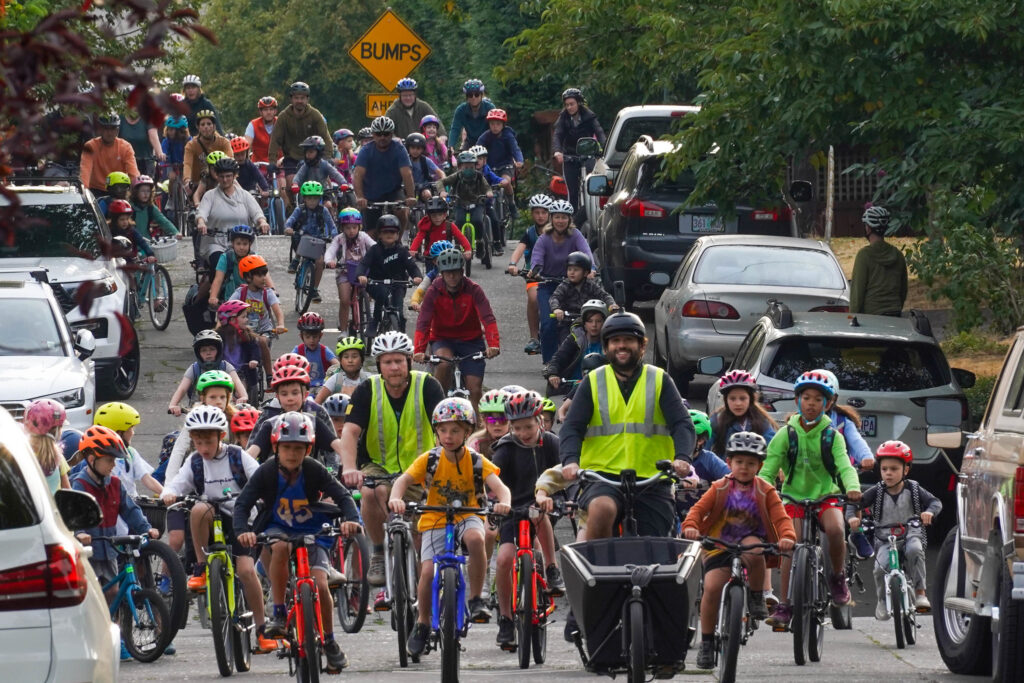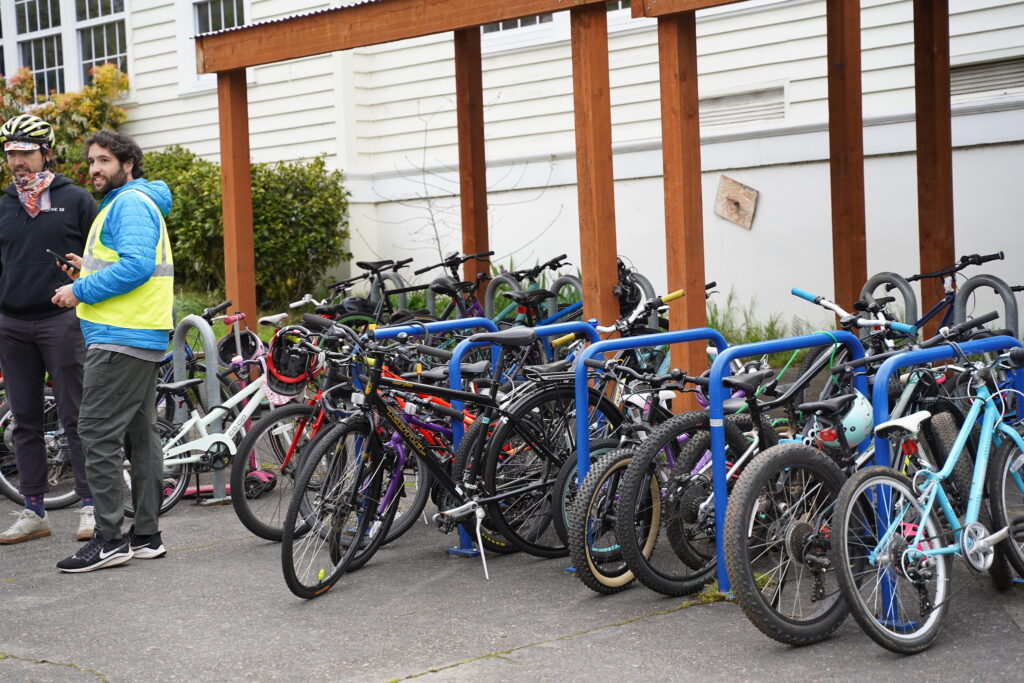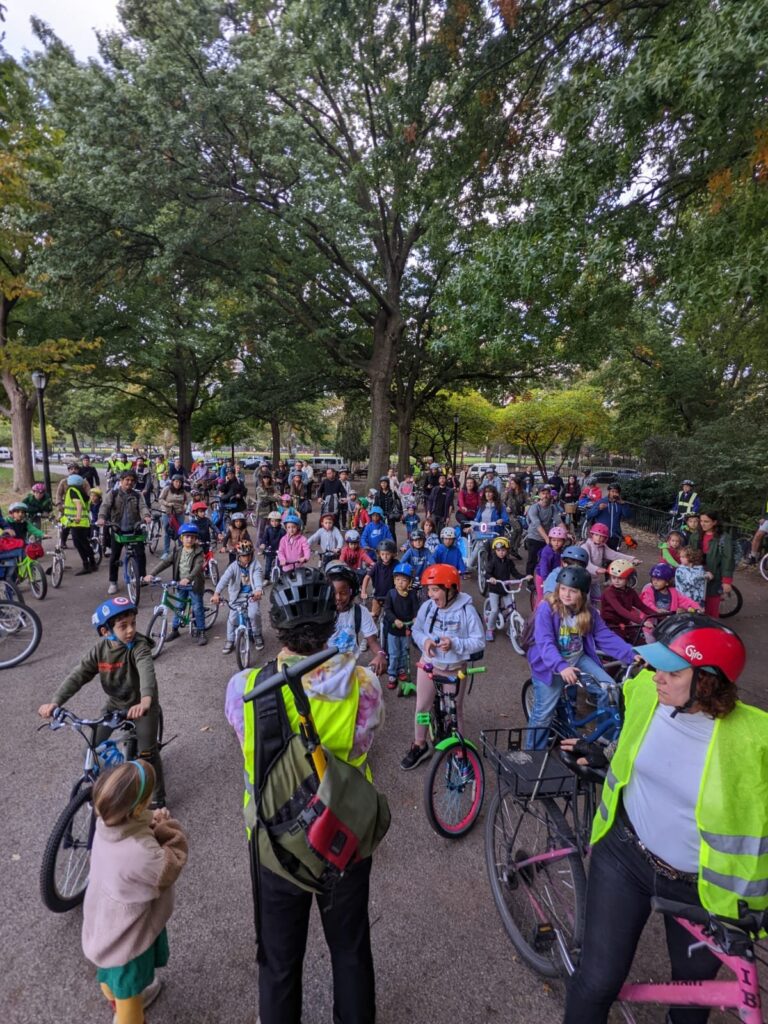By Daniela Finlay

Coach Sam Balto’s TikToks often get thousands of views, with some even reaching millions of views. His comment section is filled with people saying how his videos warm their hearts, wondering why his videos make them tear up, or wishing they could do what he and his students are doing. Balto is a physical education teacher at Alameda Elementary School in Portland, Oregon, but according to his TikTok bio, he is also a bike bus Specialist. The videos he is famous for are of him and over one hundred of his students filling the streets of Portland as they ride their bikes to school in a bike bus.
A bike bus is a communal form of transportation that allows children to safely and socially bike to school. In her article “I Started a Bike Bus, and You Can Too” for Wired, Adrienne So writes, “it carries a group of children to school in the same way a regular school bus does, except everyone is on bikes. The ‘bus driver’—an adult on a bike—guides a slowly moving group ride along a predefined route. Kids and their parents join the group on their own bikes when the pack rolls by.” Making it a group experience provides the safety that just one or two kids biking alone do not get since it increases visibility. It is also a community affair, allowing students to have social interactions before school begins and fostering community engagement in the planning of the bike bus.

Balto started the bike bus as an Earth Day initiative to inspire sustainable and active transportation amongst the students at his school, with seventy-five of them showing up to the first one. It was such a success that he continued to do it through the end of that academic school year, with the last one growing to a group of 120 students. Balto’s bike bus in Portland, Oregon, is far from the only one. He mentions one in Barcelona as a source of inspiration for creating one at his school. The Barcelona Bike Bus, or bicibús as it’s called, runs through the Eixample neighborhood of the city and has garnered significant attention from news outlets. Like Balto’s, the Eixample Bicibús often attracts over one hundred participants, but it started with just five families. The street they travel down is large and busy, meaning that without the bicibús, it would be unsafe for children to bike to school. To ensure safety, the group occupies the entire width of the road. There are adult leaders at the front with others on the sides, followed by a police car in the rear. Originally, the police wanted to have vehicles on all sides, but organizers did not want such a large police presence. This is not the only bicibús in Barcelona. Fifteen routes are operating throughout the city, with an estimated 15,000 bicibús journeys taken in one year.

As bike buses like Balto’s or the Eixample Bicibús gain attention, the movement has started showing up in New York City. According to NYC Bike Bus, as of Fall 2023, four bike buses are operating in the city: the Bergen Bike Bus, the Manhattan Country School Bike Bus, the PS 110 Bike to School in Greenpoint, and the PS 372 Bike, Walk, or Roll to School in Park Slope. Some, like the Bergen Bike Bus, drop off at multiple schools and operate once a week. Others, like the Manhattan Country School Bike Bus, only serve one school and run once a month. Regardless of how each school chooses to do it, the bike bus movement has arrived in New York City.
On a cold December morning, I was able to join the Manhattan Country School Bike Bus on their monthly ride to school. We started at their regular meeting point in Marcus Garvey Park, rode down Fifth Avenue until we reached Central Park, and took West Drive until exiting the park to arrive at the school. As we biked along the route, we picked up participants, coming out to a total of fifteen riders in the group, a number that is lower than usual but still impressive for a cold morning. When I met up with them, they asked me if I wanted to be a marshal, and I was given a reflective vest, a walkie-talkie, and the job of putting myself and my bike between the group and waiting cars at every intersection that we crossed. After the ride, I had the opportunity to talk with two of the organizers of the bike bus, Carole Maisonneuve and Michelle Montgomery.
Their bike bus was started two years ago. It was a rainy day, and only two families showed up, but it was like a playdate, so the students still had fun. Like Balto, they were inspired by the videos coming out of Barcelona. They attribute part of their success in growing from just two families to, at times, over twenty-five people to the support they have had from their school. Although the bike bus is not organized by the school itself, the school has been encouraging the initiative and has allowed them to put information in the school newsletter, put up posters, and work with the Parent Association to spread the word. The support from the school was evident when the group rolled up, and there was a crowd outside the school cheering the bike bus. Additionally, they were joined by a physical education teacher who does not live near the route but went out of his way in the morning to join the group.

Bike buses get students to school, but they also provide them with other benefits, like the safety that comes with traveling as a group. One of the most popular routes in Barcelona crosses six-lane and four-lane streets that would be dangerous to cross without the security of the bicibús, leaving students to either walk to school or take public transit. Maisonneuve and Montgomery described safety as their number one concern, even having been told that a bike bus could not be possible in New York City because of the lack of safe bike lanes. They point out that their safety concerns are evident in the route that they chose. They only take protected bike routes because they have children of varying biking abilities and most of their riders are quite young. The Manhattan Country School bike bus meets at Marcus Garvey Park, which is to the east of their final destination. However, the route they chose has to take them even further east because Fifth Avenue is the only acceptable protected bike lane that takes them south to Central Park. Even with this route, there is a small section where the bike bus is forced onto the sidewalk because the street has only an unprotected bike lane. The poor street design connecting Harlem and the Upper West Side forces them to take a longer route than might otherwise be necessary. In addition to the route design, they also have adult marshals that keep the group safe. There is one at the front, one at the back, and at least two to stand between the group and traffic at each intersection to protect the group from impatient drivers. One of the parents in the group was trained as a marshal by Transportation Alternatives, a safe street advocacy group in New York City.

Cycling has no significant environmental consequences, meaning that a bike bus is among the most sustainable forms of transportation a student can take to school, especially when the alternative is being driven to school. The bike bus helps the environment in the short term by helping more people use bikes as a form of transportation, but researchers are hopeful that initiatives like a bike bus will have long-term impacts. Jordi Honey-Roses, a researcher at the Institute for Environmental Science and Technology at Barcelona’s Autonomous University, said to Horaci Garcia at Reuters, “We anticipate that children who participate in ‘bicibús’ will be more likely to ride a bike, have better cycling habits, more sustainable transportation habits, and we think they will change the travel patterns of their family as well.”
Having community and social time before school is important for the students as well. This quality time before class has had benefits in the classroom, with teachers reporting that they notice a difference in their students when they take the bike bus to school. Lola, a four-year-old participant in Barcelona, told Stephen Burgen at The Guardian: “What I like best about the bicibús is meeting girls and boys I don’t know from other schools.” Maisonneuve and Montgomery emphasize the community aspect of their bike bus, describing the monthly event as a community event. They describe their kids as taking the bike bus very seriously and that, at times, the kids are the ones making sure the parents take them to the bike bus and not the other way around. They also mention that the bike bus allows kids to have autonomy in a world where they often have little. Although they are on a predetermined route, they get to be in control of their own bike. They have to be aware of their surroundings and their speed as they bike alongside the rest of the group. It gives them more command and responsibility over their own commute, even if they are not choosing exactly where they are going. This sets up children well for when they get older and start to navigate the city on their own.
I asked Maisonneuve and Montgomery if they thought that the bike bus model could be replicated in other schools, and they said absolutely, especially schools near Central Park because that provides one big protected bike lane for commuters to use. However, when talking about barriers to entry, they mentioned location and infrastructure as a big one. They are lucky to have the park that enables a car-free ride for a large chunk of their commute, but the lack of safe bike infrastructure at the beginning of the route in Harlem makes it difficult for them to organize the route and difficult for families who do not live near the starting point to get to the bike bus. For schools in neighborhoods with poor bike infrastructure, it would be harder for them to organize a bike bus route, and the placement of bike infrastructure often reinforces existing inequalities in the city. Within the ten New York City council districts with the highest poverty rates, there are fifty-eight percent fewer protected bike lanes compared to the rest of the city. However, commuters bike to work at a similar rate. When looking at the ten city council districts with the largest populations of people of color, there are eighty-three percent fewer bike lanes than the ten council districts with the largest white populations. They see this difference when they travel from Harlem — the city council district in Manhattan with the lowest percentage of protected bike lanes, ranking twenty-eighth in the city — to the Upper West Side, which is in the city council district with the third-highest percentage of protected bike lanes in the city. They also noted that on-street bicycle parking infrastructure is scarce, but it is their only option.
Another barrier to entry is equipment like bikes, locks, and helmets. They said they are willing to help families find a free or affordable bike for their children if they do not have one and that they see children’s bikes on Buy Nothing groups. Additionally, for families whose children may have bikes but the parents do not, they have partnered with Citi Bike to provide free twenty-four-hour passes, which allows parents not only to have a bike for the bike bus but also to use the bike for the rest of their commute that day. In addition, they make sure to bring extra helmets and extra locks for people who might not have a good quality lock.
The bike bus alone will not revolutionize bike commutes for children, and bike bus organizers know this. Bicibús organizers in Barcelona have gone to their City Council with a set of demands that includes but is not limited to, more bike parking (an issue many bike buses have come across) and more bike lanes. Balto was able to get a bill introduced in the Oregon state legislature to expand the ways that schools can use their public transit funds to support alternative forms of transportation like bike buses. The Manhattan Country School Bike Bus organizers are in contact with Transportation Alternatives and have been connected with another school in the neighborhood that also has a bike bus to be a resource for other schools thinking of creating a bike bus. They are also big supporters of the Transportation Alternatives campaign for a Central Harlem Bikeway, which would create a safer bike route through Central Harlem. The bike bus needs to exist because our cities and streets are not designed for children.
In 2023, bike bus organizers from around the world gathered in Barcelona for the first annual Bike Bus Summit. At the event, they drafted the Barcelona Declaration, which reads: “The #Bicibús is joy and freedom. Community bike rides to school make boys and girls happier, awake, and ready to learn. Our community becomes more connected and resilient. We show that our streets can also be for the little ones. As a #Bicibús community, we demand that our political leaders prioritize urban space and resources for child-friendly, healthy, and safer streets.” At the end of the day, the joy and community that the bike bus provides has to be inextricably linked with advocacy for more child-friendly streets.
Daniela Finlay is a student in the Master of Urban Planning program at Hunter College. She is interested in parks, public spaces, and urban history.

